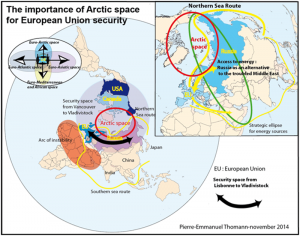The Arctic space will be at the center of the political and scientific attention during the next conference on the Arctic area in Ottawa Canada, the 8- 12 December 2014[1].
The growing international focus on the Arctic area could be an opportunity for the European Union to build an all inclusive strategy for this future strategic region and try to contain the current developing confrontation scenario along geopolitical rivalry projects.
The definition of the interest of the European Union should derive from its geographical position. The European Union is situated at the crossroads between the Euro-Arctic, the Euro-Atlantic, the Euro-Asiatic and the Euro-Mediterranean and African geopolitical spaces. So far, the policies developed by the European Union in the Arctic space are the less advanced[2] compared to other regions but Member States decided to engage themselves more[3]. On the principle of equilibrium, it would be the European Union interest to anticipate future geopolitical challenges in this area.
Not only Arctic States[4] are concerned by Arctic challenges but all Member States of the EU. A more ambitious EU Arctic policy is the occasion to strengthen the relations between EU and Asia and to redirect the relations with Russia on a positive track. Future European security lies in the negotiation of a common security space from Lisbonne to Vladivostok. The potential Northern Sea Route along Russian coast is also the shortest Sea route between Europe and Asia and also could be pivotal for raw materials access for the EU in Siberia as an alternative to the troubled MENA region. The Northern Sea route would also be a more secure alternative to the Sea route (avoid piracy) South of the Eurasian continent (see on the map above).
The objective would also be to moderate any potential future confrontation between the United States and Russia in this area as the European Union would be forced to choose its camp and might lead to a new division line on the Eurasian continent.
Avoid the Arctic to become the place of a new geopolitical confrontation
As we can see on the map (the importance of Arctic space for European Union security), the Arctic region should become a zone of cooperation as the European Union is already confronted to an arc of crisis on its Southern flank and the conflict in Ukraine might reinforce another arc of crisis on the EU Eastern flank. We do not need to face there another field of confrontation like it was before in Latin America, Middle East or Northern Africa. EU Member States should develop a proper and adequate Arctic Policy based on smart management and engagement of all interested actors of the region. If not, Arctic might become a new division line for the European continent.
The danger is that the Arctic region becomes a new front between the United States against Russia or even China and that NATO Member states gets sucked up in a new confrontation and make impossible for the European members to adopt an independent policy. The potential for new trade routes through the Arctic Sea would reduce the time needed to transport goods between Europe and Asia and the Arctic is therefore an important part of China’s global strategy for its economic activity but also for its navy, although China is not an Arctic State like Russia.
Analysis of the US government strategy for Arctic[5] depicts that Washington stakes on military capacities and capabilities in projection of its national interests in the region. The national Arctic strategy states that one of the priorities is to « Advance United States Security Interests – We will enable our vessels and aircraft to operate, consistent with international law, through, under, and over the airspace and waters of the Arctic, support lawful commerce, achieve a greater awareness of activity in the region, and intelligently evolve our Arctic infrastructure and capabilities, including ice-capable platforms as needed. U.S. security in the Arctic encompasses a broad spectrum of activities, ranging from those supporting safe commercial and scientific operations to national defense ».
The US officials are eager to use NATO and its EU allies to complement American foreign policy. Already in 2009, the then Secretary General of NATO Mr. De Hoop Scheffer declared that “The changes caused by the progressive melting of the ice cap are of concern to many countries beyond those of the Arctic Council and NATO. Indeed, the whole of the international community stands to be affected by many of the changes that are already taking place. In this situation, NATO needs to identify where the Alliance, with its unique competencies, can add value.”[6]
The Norvegian government has asked regularly more NATO involvement in the Arctic region since the Ukraine conflict[7]. Although former NATO Secretary-General Anders Fogh Rasmussen said “At this present time, NATO has no intention of raising its presence and activities in the High North,” [8]. the situation might rapidly change with the new Norvegian Secretary General and the pressure of some Member States to gradually involve NATO.
Artic as a bridge for cooperation
As Arctic plays a great value as the future source of raw materials, the question is if there is a State which is really able to control on its own the way from extraction to delivery and sale of oil and gas from the Arctic shelf. The answer is “no”. Some States (the US, Canada, Europeans) have the necessary technology. Some have at their disposal fleets of ice-breakers (Russia, China). Some countries possess the necessary practical experience of managing extraction in extreme weather conditions (Sweden, Norway). But no country is capable to do it all separately without sharing a burden with other actors.
Arctic region should to become a crossroad for all-weather dialogue between the different neighboring states and international actors. It could demonstrate the will and ability of nations to coordinate foreign policy and to resolve upcoming challenges and threats on a mutually beneficial basis. European Union has potentially an ambitious role to play there.
